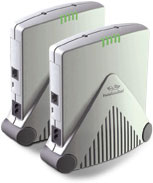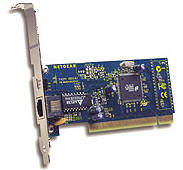| |
|
|
|
|
|
|
By Cheryl Currid
And one by one, engineers took the "never" as a challenge. Well, here goes another one. To those who said you can never pass data over electrical wires: Wrong again. I've found a product that can make any electrical outlet in a home into a local network connection. The product is the QX-201 NeverWire 14 from Phonex
Broadband of Midvale, Utah. And its easy setup and reliable operation
continue to amaze me.
My house is a minefield when it comes to electrical wiring. I've got all kinds of things that put noise on wires, such as high-intensity bulbs, tons of fluorescent fixtures, a gaggle of low-power devices and dozens of dimmer switches. On top of that, I have 79 X-10 devices that use the power lines to turn on and off lights, pool pumps and drapes. To my delight, NeverWire products worked immediately. I tested units as a print server, a hub to the cable modem and a network in a peer-to-peer configuration. All the PCs I used have Windows XP, Home or Professional versions. In fact, the system worked where no other has before. For example, I have two rooms in my house that I call "dead zones." I don't know what the builder put between the walls, but these rooms are like bomb shelters. Nothing goes in or out. Other than by direct wiring, all attempts to network powerline or wireless devices into those rooms have failed. But when I plugged in the NeverWire system, it didn't even hiccup. It just worked. Phonex Broadband has a winner here. The products are easy to set up and (so far) flawless. The system has security encryption and supports up to 16 units per power line network. The data travels at 14 megabits per second, which is more than 10 times faster than most cable modems and DSL lines. And while it is slower than my hard-wired system that runs at 100 megabits per second, the difference isn't noticeable for most applications. There are very few requirements to make this system work. Just make sure that each PC or laptop is equipped with an Ethernet connection. If you have an older computer, you may have to add that card.
NeverWire 14 can even bridge to another network, if you already have one installed. So if you've started yanking up the carpets or drilling into your ceiling, hold onto your hard hat. The NeverWire 14 is the easiest way to network your home today. For more information, or to purchase the unit, check out the Phonex Broadband Web site at www.phonex.com. For details about the technology that powers data over the power line, visit the HomePlug Powerline Alliance Web site at www.homeplug.org.
This article originally appeared in the Houston Chronicle, August 1, 2002 Copyright ® 1997-2003, Currid & Company, Inc. The Currid Collection articles are part of a series featured in Hearst Publications. If you are interested in obtaining reprints for this, or any, column published by Currid & Company associates, please contact Webmaster by email at webmaster@currid.com.
|
|
|
|
|
|
|
www.currid.com |
| Copyright 2006 Currid & Company. All rights reserved |
 When
it comes to technology, never say never. Over my career, I've heard
people say that printers will never print faster than a pokey 10
characters per second, or PCs will never be as fast as minicomputers, or
that high-speed data will never travel across telephone lines.
When
it comes to technology, never say never. Over my career, I've heard
people say that printers will never print faster than a pokey 10
characters per second, or PCs will never be as fast as minicomputers, or
that high-speed data will never travel across telephone lines.

 But
with prices as low as $15.99 for a Netgear PCI card, they're very
affordable. And most computers purchased in the last two years already
have that Ethernet port built in. On the powerline side, just make sure
to plug the NeverWire 14 directly into an unprotected outlet, and not
into a surge protector.
But
with prices as low as $15.99 for a Netgear PCI card, they're very
affordable. And most computers purchased in the last two years already
have that Ethernet port built in. On the powerline side, just make sure
to plug the NeverWire 14 directly into an unprotected outlet, and not
into a surge protector.